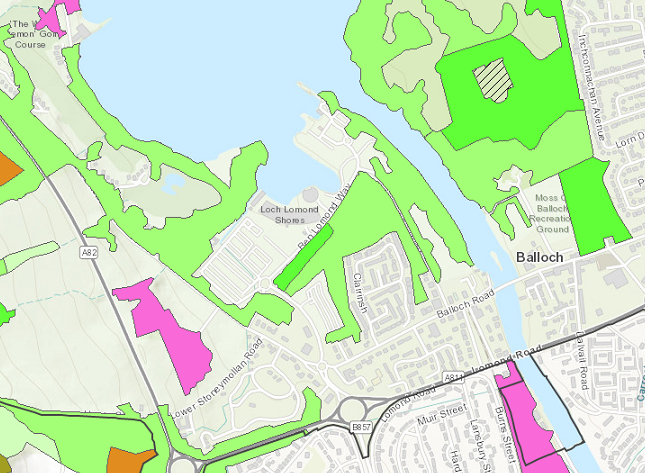 Balloch is a village nested in woodland as the online map (above) from the Loch Lomond and Trossachs National Park Authority (LLTNPA’s) Trees and Woodlands Strategy 2019-39 shows (see here).
Balloch is a village nested in woodland as the online map (above) from the Loch Lomond and Trossachs National Park Authority (LLTNPA’s) Trees and Woodlands Strategy 2019-39 shows (see here).
In my view, any plan to improve the “visitor experience”/tourism at Balloch should start from the fine views from the loch shore, the remaining open spaces and the woodland. Instead, Flamingo Land’s proposals will develop the loch shore blocking the view, fill up the open spaces and, as this post will show, reduce both the extent and the quality of the woodland.
I also this video (see here) – in which parkswatch features – which gives an excellent and humorous overview of the woodland issues. Please share.
Flamingo Land’s promise to protect Drumkinnon Woods
In June (see here) I explained how, while Flamingo Land had removed most of the development proposed for Drumkinnon Woods, they had not removed the staff service area (Area 10 on their maps). Although the mapping of ancient woodland sites in Scotland has not been an exact science, there is no doubt that some of Area 10 was part of Drumkinnon Woods before it was severed by the construction of Ben Lomond Way, the road which leads to Loch Lomond Shores.
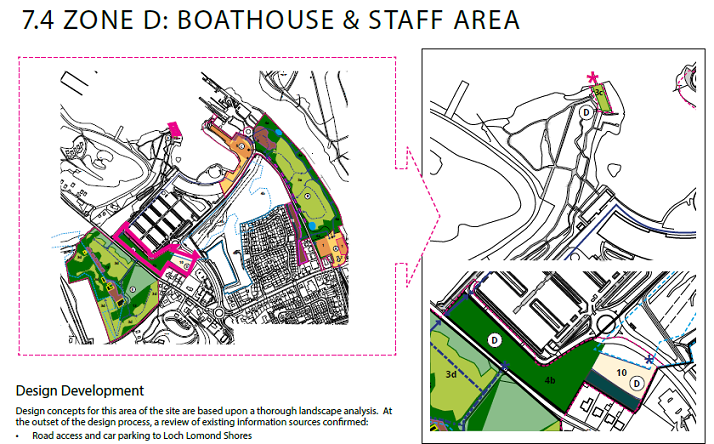 Flamingo Land’s plans show the ancient woodland site extending to the south of Ben Lomond Way (dotted blue line above) and that they propose to build an 8m high service building immediately adjacent to it. That would have a massive impact on this fragment of Drumkinnon Woods, which they accept is ancient, damaging the root systems of trees and changing the microclimate (shade, shelter etc in the lea of the building)
Flamingo Land’s plans show the ancient woodland site extending to the south of Ben Lomond Way (dotted blue line above) and that they propose to build an 8m high service building immediately adjacent to it. That would have a massive impact on this fragment of Drumkinnon Woods, which they accept is ancient, damaging the root systems of trees and changing the microclimate (shade, shelter etc in the lea of the building)

Work by local residents, however, suggests that the ancient woodland boundary is NOT where Flamingo Land claims but actually covers most of the proposed service area
After the National Trust for Scotland objected to the application and cited the destruction of ancient woodland in Area 10 as one of its reasons for doing so (see here), an article appeared in the National in November (see here) quoting Jim Paterson, Development Director for Lomond Banks:
“We remain committed to our plans for Lomond Banks, and have spent a great deal of time looking at how we support the local business community and protect the very things that make the area special, such as the ancient woodland of Drumkinnon Wood which has been completely removed from the development area.”
That claim is highly misleading.
Four days ago, Flamingo Land – in their current guise of Lomond Banks – issued a news release (see here) claiming to be making a legally binding Promise about various aspects the development which was again covered in the National (see here). While the “contract” Flamingo Land has drafted has not yet been published on the LLTNPA’s planning portal (see here) (and will be worthless unless it provides those affected a means to enforce it), Mr Paterson made the following claim:
“Concerns over the potential impact of the development on the ancient woodland of Drumkinnon Wood have also been addressed as part of the promise, which states that following consultation, a Woodland Management Plan for the protection, maintenance and enhancement of Drumkinnon Wood and the informal woodland path network would be introduced to preserve and protect the area.”
How erecting an enormous building along what they claim to be the boundary of the ancient woodland site will do that is not explained.
The native woodland habitat network at Balloch
The issues, however, are not just about what is ancient woodland and what is not. A few years ago Scottish Forestry undertook a digital mapping exercise to provide an “Integrated Habitat Network” of native woodland across Scotland for forestry grant purposes (see here). A snapshot of the core native woodland areas in Balloch (blue) is very revealing:
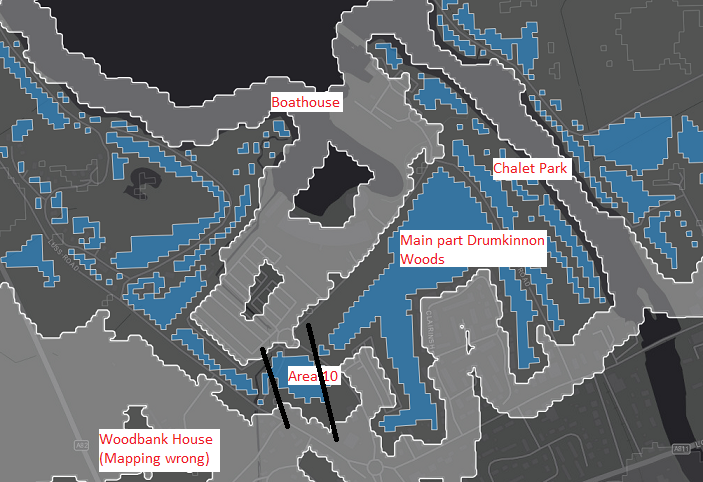
It shows an extensive native woodland network which, while split into many segments, does provide corridors for wildlife. This helps explain why roe deer are sometimes present in the main part of Drumkinnon Woods – they have been seen swimming across from the native woods on the other side of the River Leven! – and offers a route for the Red Squirrel which have been steadily spreading south to re-colonise Balloch.
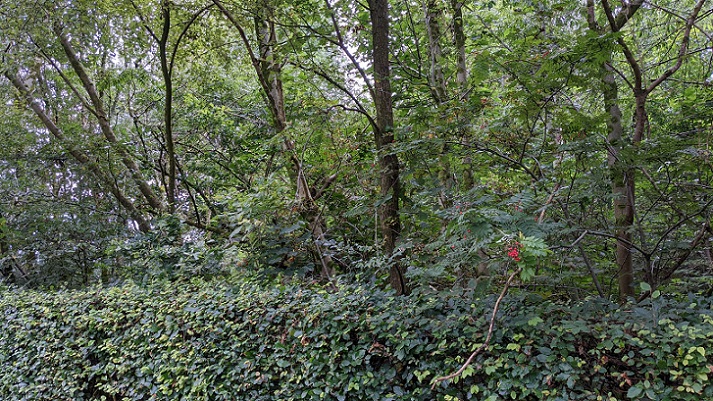
Rather than enhancing this native woodland network, Flamingo Land’s proposals will chop it up further. The development of Area 10 will not just destroy a piece of ancient woodland, it will almost sever Drumkinnon Woods from the strips of native woodland connecting up to the west shore of Loch Lomond. The development of a chalet park and monorail along most of the Riverside Site will do the same on the eastern side of Drumkinnon Woods.
The key issue is not about people being able to enjoy degraded and isolated woods, which is what Flamingo Land is proposed, its about how the proposed development will destroy the habitats which would enable people, both locals and visitors, to enjoy far more wildlife at the “gateway” to the National Park.
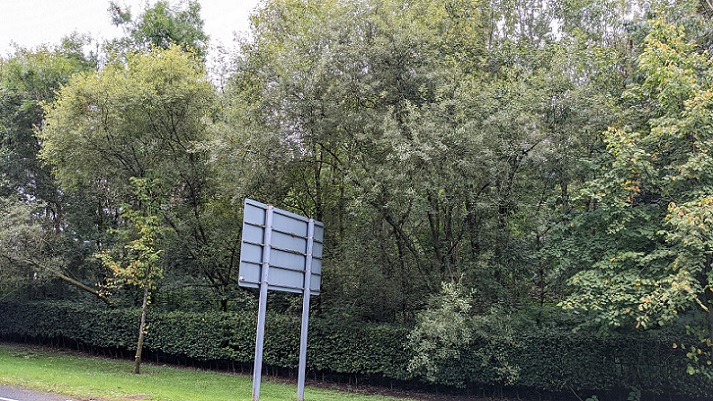
In September, I went and had a look at the woodland around Area 10 and bordering the main Lomond Shores car park:
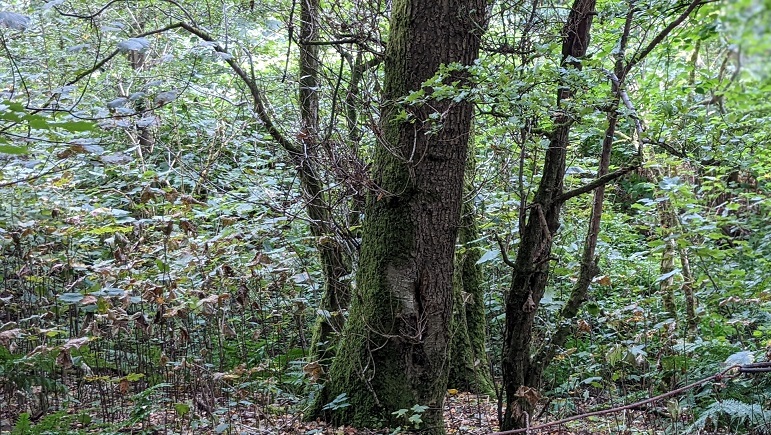
This woodland may at present, according to Flamingo Land’s Environment Impact Assessment, lack rare plants and animals but actually it looks pretty good. There is a healthy understorey in the planted strip, with some self-seeded saplings, while the maturing trees should provide a home for increasing types of wildlife. It does not need gardening or improving as Flamingo Land proposes, rather it needs time to wild further.
If we want to reverse the crisis in nature, in Scotland we need to starting valuing woodland not just for its actual value but its potential value. Otherwise no new species rich woodland will ever develop. Native woodland networks have a key role to play in enabling rich woodland to develop but there is just a single reference to them in Flamingo Land’s main Environmental Impact Assessment report.
The impact of the Flamingo Land development on woodland in Balloch
The documentation accompanying Flamingo Land’s application attempts to dismiss the woodland on the site as having any value that might obstruct their development interests while making vague noises about its importance. For example the Design Statement for Woodbank House states Flamingo Land will “Retain large Mature good quality tree species of significance throughout the landscape such as Cedar, Pine and Oak”.
When it comes to nature, however, it is not just “mature” trees that count. If that was the case, we would have no woodland, while “good quality” has a very different meaning to what Flamingo Land proposes: it includes dead and dying trees which provide holes for nesting birds, food for woodpeckers etc.
Despite pages of material, Flamingo Land’s plans are extremely vague about what trees and woodland will be removed from where and what will be subject to the enhanced management which Flamingo Land repeatedly mentions in their Design Statement:

After all the work done by local residents on Drumkinnon Woods, it appears that LLTNPA’s planners may now appreciate this major hole in the application. In a lengthy email dated 17th November (see here) – all credit to planning staff for publishing this on the planning portal – asking for more details about various aspects of the proposed development, they asked this about the potential impact of the proposals on woodland: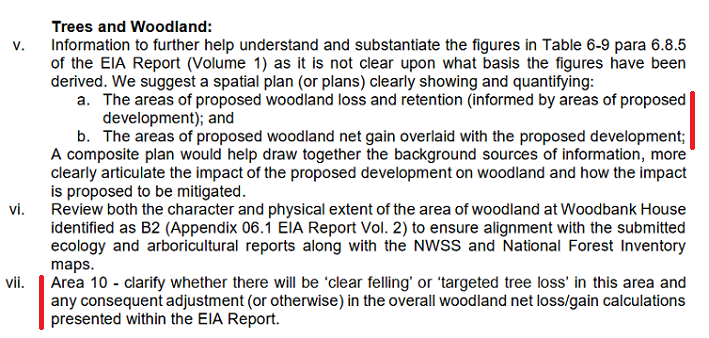
The email also sought “Clarification in relation to the location of the 35 parking spaces for the ‘staff and services area’ (this is presently suggested as being within the brown shaded areas
within the key and not expressly within Area 10).”
If the planners cannot get to the bottom of what is being proposed, what hope that any member of the public can make informed comments on the application? About all we know for certain about the application is that at least 0.48 hectares of ancient woodland will be lost.
Flamingo Land, woodland policy and the LLTNPA
The LLTNPA’s policy on woodland is extremely weak. Their Trees and Woodland Strategy (2019-39), for example, says almost nothing about the importance of woodland around settlements, whether to people who there or to visitors. While the strategy earmarks most of the area around Loch Lomond as an opportunity to develop “Atlantic Woodland”, Balloch is left out and along with that the opportunity to join up the woodland network around the bottom of Loch Lomond:
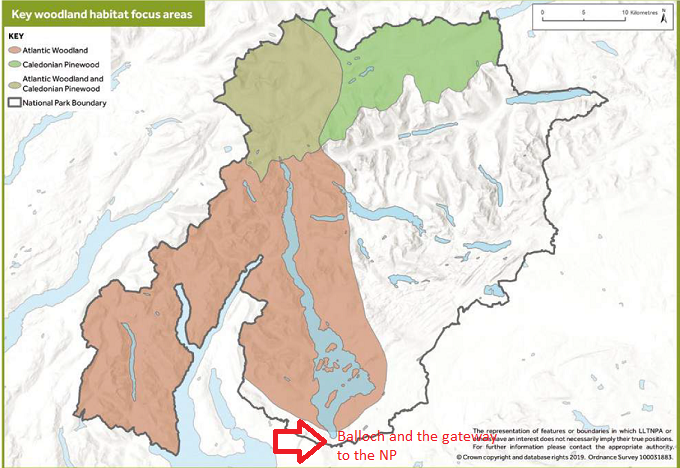
The omission of Balloch, with its core native woodland habitat network, from the LLTNPA’s Atlantic Wood “focus area” is not, I believe, a coincidence. Having been behind the development from the star and been on the interview panel which appointed Flamingo Land as preferred developer (see here), the LLTNPA did not want to create any more local policies which would get in the way of it being approved.
What is staggering is that having never included either the main part of Drumkinnon Woods or Area 10 in the Local Development Plan as being areas suitable for development, the LLTNPA is still swithering when it comes to protecting woodland in these areas and giving Flamingo Land another change to justify the damage their proposals will cause.
Luckily, matters are being taken out of the LLTNPA’s hands. National Planning Framework 4 (see here), as laid before the Scottish Parliament on 8th November, contains new strengthened policy on the role of woodland in the climate and nature emergencies:
“Local Development Plans:
LDPs should identify and protect existing woodland and the potential for its enhancement or expansion to avoid habitat fragmentation and improve ecological connectivity, helping to support
and expand nature networks. The spatial strategy should identify and set out proposals for forestry,
woodlands and trees in the area, including their development, protection and enhancement,
resilience to climate change, and the expansion of a range of types to provide multiple benefits. This
will be supported and informed by an up to date Forestry and Woodland Strategy.”
Sadly, the LLTNPA’s Local Development Plan expired in 2021 but “will remain in place until 2024 to align with the new planning legislation” while its Trees and Woodland Strategy, which never was fit for purpose (see here for example) is now completely out of date. Neither are compatible with the Scottish Government’s new planning policy on woodland:
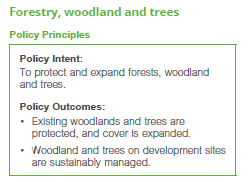
NPF4 goes on to state:
“Policy 6
a) Development proposals that enhance, expand and improve woodland and tree cover will be supported.
b) Development proposals will not be supported where they will result in:
i. Any loss of ancient woodlands, ancient and veteran trees, or adverse impact on their
ecological condition;
ii. Adverse impacts on native woodlands, hedgerows and individual trees of high biodiversity value, or identified for protection in the Forestry and Woodland Strategy;
iii. Fragmenting or severing woodland habitats, unless appropriate mitigation measures are identified and implemented in line with the mitigation hierarchy;”
The LLTNPA appears to have realised the changed policy context when it recommended rejecting the Loch Long fishfarm (see here) recognising, for example, that “ancient woodland is effectively irreplaceable”.
At the end of its email to Flamingo Land of 17th November asking for more details about various aspects of the proposed development, including the impact on woodland, the LLTNPA also requested:
“Please provide a detailed assessment this proposed development against the revised draft NPF4 which was laid before the Scottish Parliament on 8 November 2022. This is in anticipation that the National Park Authority will be required to assess the application against the NPF4 to be approved by Parliament”.
It may therefore be that the LLTNPA’s out of date plans will become irrelevant and all that will matter is NPF4. If that is the case, either Flamingo Land’s current proposals are doomed or the LLTNPA will demonstrate that Scottish Government policy is worthless at its first test.
What people can do to help
If my analysis is correct, there are two things that people concerned about the impact of Flamingo Land’s proposed development on woodland can do:
- The first is to comment/submit further objections to Flamingo Land’s proposal in the light of NPF4 asking that the LLTNPA take account of the changed policy context (see here)
- The second is to lobby MSPs across the country calling for NPF4 to come into effect as soon as possible and the policies it contains to replace those in out of date Local Development Plans (like that of the LLTNPA). The argument for this is that with the climate and nature emergencies we can afford no more delays, and certainly not wait until 2024 when the LLTNPA proposes to agree its new LDP

A news report today explains the value of mature woodland for carbon capture and storage and how this value has been underestimated in the past (https://www.bbc.co.uk/news/science-environment-64028694). These studies, using new techniques including lasers and 3D scanners and carried out in one of the world’s most studied woodlands, Whytham Woods near Oxford, led to the following conclusion “The value you have in large mature trees is almost incalculable, and so you should avoid losing that at any cost – regardless of how many trees you think about planting” (Prof Mat Disney, University College London). On this basis we can conclude that the felling of any mature trees and associated vegetation through the Flamingo Land proposals would be inexcusable and no less than ecological vandalism. And at complete variance with the biodiversity objectives agreed by all governments at the COP summit in Montreal, Canada, on Sunday.